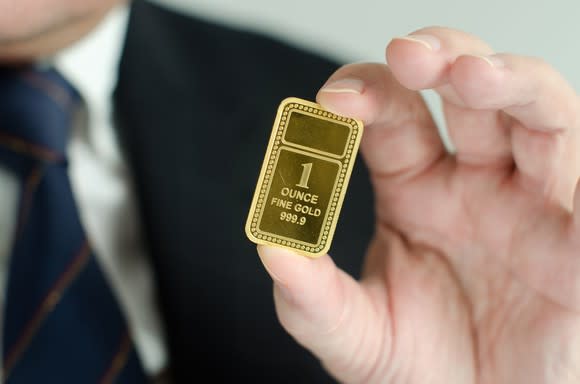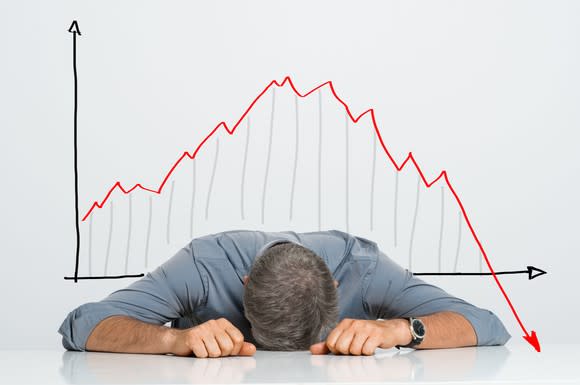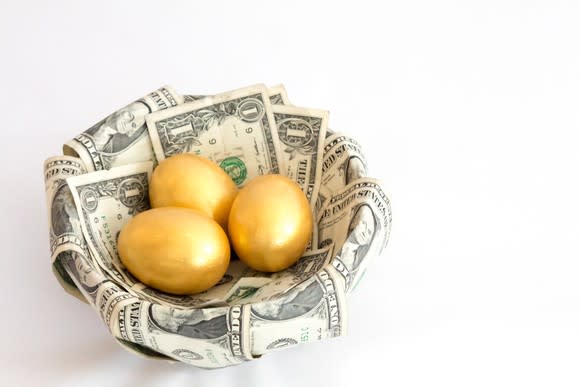The 5 Biggest Myths About Gold

Image source: Getty Images
Gold was once a common form of payment around the developed world, but after World War II the precious metal's influence began to wane. In 1971, when the United States finally put an end to the gold standard, the role of the yellow metal changed for good. But that doesn't mean gold is just an antiquated relic or a bad investment; you need to get past such myths about gold to understand its place in the world, and, perhaps, your portfolio. Here are five myths about gold debunked.

Jewelry is one of the main uses of gold today. Image source: Getty Images
1. There's a firm answer to whether gold is or isn't money
There's no point in trying to prove that gold is money, or that it isn't. Because, in many ways, the answer is yes -- to both. Roughly 9% of the demand for gold in 2016 came from central banks and other financial institutions. Gold bars and gold coins, meanwhile, accounted for another 24% or so of total demand. So roughly a third of gold demand in 2016 came from consumers looking at money-like uses for gold. American Eagles, interestingly enough, are stamped with "face values" that range from $5 to $50.
That said, around 47% of gold demand in 2016 came from jewelry. That's a huge percentage, and clearly not related to money in any way. Buying a fancy gold necklace might be a way to show how wealthy you are, but you certainly aren't doing it with the intention of using the necklace as a form of currency. The rest of the demand for gold comes from things like dentistry and technology, which are even further estranged from money.
The real answer here, however, is that it doesn't matter. You clearly can't walk into your local grocery store and plunk down gold bullion to pay your bill, or at least I don't recommend it. Even though American Eagles have a "face value," they are considered collectibles and are worth far more than the dollar figure stamped on them. At the same time, you can easily exchange gold for dollars. Even a gold necklace can be sold fairly quickly (for the value of the gold at least, if not the full value you paid for it). So gold is more than a collectible, but maybe a little less than a currency.

Gold ingots and bullion are the most common ways to own physical gold. Image source: Getty Images
2. You shouldn't own physical gold
If gold is only kind of money, why bother owning physical gold at all? The truth is, owning gold can be a real pain in the neck. For example, if you buy a gold coin you'll likely pay a markup over the value of the metal contained in the coin. If you buy direct from the U.S. Mint the markup helps to pay for the stamping of the coin. If you buy from a dealer, the markup is the dealer's commission.
Once you have the gold, meanwhile, you have to do something with it. You could stuff it in a drawer, but that seems like a bad call for something that could be worth hundred or thousands of dollars. That might mean you buy a safe or put the coin in a bank safe deposit box. Either way, you are now paying for the privilege of owning the gold you bought. So far, owning physical gold sounds like a bad proposition -- unless, of course, something really bad happens.
No, I'm not suggesting the zombie apocalypse, though recent research suggests that around 5% of Americans do actually fear such a thing. But it's not unrealistic to suggest that a war or other event could materially disrupt the world's financial systems. War, for instance, is feared by nearly 50% of Americans, while a financial collapse worries about 45% of us. In either case, if fiat currencies like the dollar became worthless, your gold coin would suddenly have a lot more functional value -- anywhere in the world.
It doesn't make sense to have all of your wealth in gold, but it's probably not a bad idea to consider owning some physical gold or silver. Just in case.

Gold is an often volatile commodity. Image source: Getty Images
3. Gold is an awful investment
Gold bugs love it (I wonder how many gold bugs believe in zombies?), and others hate it. The problem with gold as an investment, of course, is that it's a commodity subject to often volatile and extreme price swings. But there's a limited supply of the metal, and, as noted above, it can be easily exchanged for cash. That makes it a physical store of wealth with a price driven by investor sentiment. Many people attempt to time the ups and downs of gold. Only in this case, fear will usually drive the price of this precious metal higher.
Last time I checked, market timing was hard to do successfully on a consistent basis. And if that's what you're looking at gold for, I'd argue it is likely to be an awful investment. But here's the thing: fear tends to drive people toward safe haven investments that will retain value in a worst-case scenario. That's gold, in a nutshell. And, thus, gold tends to do well when other assets (like stocks) are doing poorly.
To put a number on that, during the 2007 to 2009 recession, gold ended the period up around 20%. The S&P 500 Index, meanwhile, was lower by about 40%. Clearly, that was a good time to own gold! And for those who don't recall, there was a real fear at the time that the global financial system was on the verge of collapse.
So, perhaps, the real question isn't whether or not gold is a good investment, but why you are buying gold in the first place. If you are looking for diversification, or a safe haven, then gold can play a vital role in your portfolio. You should, however, keep the percentage relatively small. On the other hand, if you are trying to time gold's price swings you're probably making a mistake.

This is old school mining, it's generally not done this way anymore. Image source: Getty Images
4. Owning gold miners is better than owning gold
This is a tough one and, like point number one above, the answer can go either way. If you want to own gold in preparation for a worst case scenario (there go those zombies again), then owning gold will be much better than owning stock in a gold miner. And if all you desire is a safe haven investment, then direct purchases of gold are the purest way to achieve that end.
That said, buying a gold exchange traded fund like iShares Gold Trust (NYSEMKT: IAU) would achieve a similar end. This fund's portfolio consists of gold bars held in London, New York, and Toronto. Thus the fund's performance generally tracks gold and allows you to avoid the problems of owning physical gold while still getting most of the benefits.
Owning gold miners, however, is a little different. In this case you own a company, such as industry giants Barrick Gold, Goldcorp, and Newmont Mining. Since what these companies do is mine for, process, and sell gold, their performance tends to track along with the price of the precious metal. And, along the way, each of these companies pays you a dividend. The yields today are modest, all under 1%, but that's much better than what you'll get with physical gold or iShares Gold Trust.
The problem here is that you are subject to the inherent risks of miners. Rising costs can reduce earnings and push down financial results. Meanwhile, aging mines can lead to falling production over time, and new mine developments can prove to be expensive mistakes. There are other problems that might arise, too, but you get the idea. When you buy a gold miner you own a company, and companies can make mistakes.
On the flip side, the shares of gold miners can sometimes move more dramatically than the precious metal itself. That's particularly true for smaller miners and marginal miners that need high prices to turn a profit. Sometimes a mining stock can double and triple in value when gold goes up much less. Of course, what goes up can also go down, so there are risks here, too. But if you are looking to leverage yourself to gold, then miners are a good bet.
So owning gold versus owning gold miners is, once again, really a question about your goals.

If you own the right gold investment, it can pay dividends in good times and bad. Image source: Getty Images
5. Your only investment choices are physical gold or gold miners
Please don't make the mistake of stopping your search for a gold investment at physical gold (or gold ETFs) and gold miners. There's one more option you should get to know before you decide how you want to own gold: streaming companies. Some of the biggest names here are Franco-Nevada Corp (NYSE: FNV), Wheaton Precious Metals Corp (NYSE: WPM), and Royal Gold, Inc (NASDAQ: RGLD).
Streaming companies provide cash up front to miners in exchange for the right to buy precious metals in the future at contractually reduced rates. To give you an idea of what that means, Wheaton Precious Metals' average price for gold is around $400 an ounce -- well below current spot prices. The business model affords these companies wide margins even when precious metals prices are low and miners are struggling. In fact, during commodity downturns streaming companies can take advantage of miners in need of cash to ink advantageous streaming deals.
All three pay dividends, with current yields between 1% and 2%. Wheaton's dividend is tied to the company's performance, so it will go up and down over time. Royal Gold and Franco-Nevada, however, both have long histories of regular annual dividend increases.
It's also important to note that these companies aren't reliant on one or two big mines (like a miner might be); they have investments in a collection of different assets, including operating mines and mines in some phase of development. Franco-Nevada, for example, has its fingers in over 300 assets. So streaming companies are probably best looked at as specialty finance companies with diverse mine investment portfolios.
In many ways, they are a better long-term option than miners. However, they don't tend to have as much leverage to gold prices. But if you are looking for a gold investment for diversification, they might end up being the best combination of gold exposure, dividends, liquidity, and ease of use. If you are looking at gold, you should take some time to get to know streaming companies like Franco-Nevada, Wheaton Precious Metals, and Royal Gold.
In the end, how you own gold is up to you and related to your personal goals. But once you get past these five myths, you'll be able to make more informed decisions about the precious metal and its place in your life and, perhaps, in your portfolio.
More From The Motley Fool
6 Years Later, 6 Charts That Show How Far Apple, Inc. Has Come Since Steve Jobs' Passing
Why You're Smart to Buy Shopify Inc. (US) -- Despite Citron's Report
Reuben Gregg Brewer has no position in any of the stocks mentioned. The Motley Fool has no position in any of the stocks mentioned. The Motley Fool has a disclosure policy.

 Yahoo Finance
Yahoo Finance 